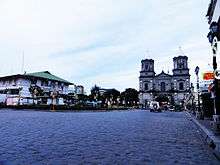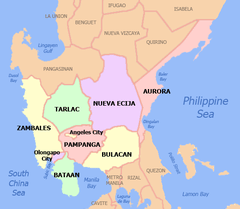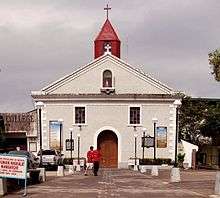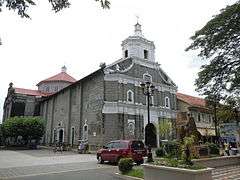Central Luzon
Central Luzon (Kapampangan: Kalibudtarang Luzon, Pangasinan: Pegley na Luzon, Tagalog: Gitnang Luzon, Ilocano: Tengnga a Luzon), designated as Region III, is an administrative region in the Philippines, primarily serving to organize the 7 provinces of the vast central plains of the island of Luzon (the largest island), for administrative convenience. The region contains the largest plain in the country and produces most of the country's rice supply, earning itself the nickname "Rice Granary of the Philippines".[1] Its provinces are: Aurora, Bataan, Bulacan, Nueva Ecija, Pampanga, Tarlac and Zambales.[4]
Central Luzon Region III | |
|---|---|
  .jpg) From top, upper-left to lower-right: Baler Bay, Sierra Madre, Angeles, Capas National Shrine, Pinatubo Crater Lake and Mount Samat National Shrine | |
| Nickname(s): Rice Granary of the Philippines[1] | |
 Location in the Philippines | |
| Coordinates: 15°28′N 120°45′E | |
| Country | |
| Island group | Luzon |
| Regional center | San Fernando (Pampanga)[2] |
| Area | |
| • Total | 22,014.63 km2 (8,499.90 sq mi) |
| Population (2015 census) | |
| • Total | 11,218,177 |
| • Density | 510/km2 (1,300/sq mi) |
| Human Development Index | |
| • HDI (2018) | 0.726[3] high · 4th |
| Time zone | UTC+8 (PST) |
| ISO 3166 code | PH-03 |
| Provinces | |
| Independent Cities | |
| Municipalities | 116 |
| Barangays | 3,102 |
| Cong. districts | 20 |
| Languages | |
Etymology
Current name of the region is in reference to its position on the large island of Luzon. The term was coined by American colonialists after the defeat of the First Philippine Republic. There have been proposals to rename the current Central Luzon region into the Luzones region. The proposed name is in reference to the old name of Luzon island, Luções, which was later used to refer to the central area of the island, stretching from Pagasinan in the north, all the way to Pampanga in the south. The term Luções literally translates into Luzones.[5][6]
Overview
The region of Central Luzon is located north of Manila, the nation's capital. Bordering it are the regions of Ilocos and Cagayan Valley to the north; National Capital Region, Calabarzon and the waters of Manila Bay to the south; South China Sea to the west; and the Philippine Sea to the east.[7] Pangasinan is historico-culturally and geographically an integral part of this region, but was politically made part of the Ilocos Region by President Ferdinand Marcos on June 22, 1973.[8]
There are fourteen cities in the region: Balanga in Bataan; Malolos, Meycauayan and San Jose del Monte in Bulacan; Cabanatuan, Gapan, Muñoz, Palayan and San Jose in Nueva Ecija; Angeles, Mabalacat and San Fernando in Pampanga; Tarlac in Tarlac; and Olongapo in Zambales. Central Luzon produces the most rice in the whole country. Excess rice is delivered and imported to other regions of the Philippines.[9]
The City of San Fernando, provincial capital of Pampanga, is designated as the regional center. Aurora was transferred from Region IV through Executive Order No. 103 on May 2002.[10]
Demographics
| Year | Pop. | ±% p.a. |
|---|---|---|
| 1990 | 6,338,590 | — |
| 2000 | 8,204,742 | +2.61% |
| 2010 | 10,137,737 | +2.14% |
| 2015 | 11,218,177 | +1.95% |
| Source: Philippine Statistics Authority[11][12] | ||
Languages
The native languages of Central Luzon are:
- Kapampangan, spoken in the entirety of Pampanga and southern Tarlac, as well as southeastern Zambales, northeastern Bataan, western Bulacan, and southwestern Nueva Ecija.
- Pangasinan, spoken in northern Tarlac, northeastern Zambales, and northwestern Nueva Ecija.
- Tagalog, spoken in Bulacan, Pampanga, Tarlac, Nueva Ecija, Aurora, Bataan, and Zambales. It is the regional lingua franca.
- Ilocano, spoken in northern Nueva Ecija and some parts of Tarlac, Zambales, and Aurora.
- Sambal, spoken in a majority of Zambales and a few scattered areas in Bataan and Pampanga.
Religion
Eighty percent of the population of Central Luzon is Roman Catholic. Other religions represented are Protestants (including Evangelicals), Islam, Iglesia Ni Cristo, and indigenous religions such as Anitism. There are also other denominations such as Jesus Is Lord, Pentecostal Missionary Church of Christ, Ang Dating Daan, Jesus Miracle Crusade, United Methodist Church and others.
Administrative divisions

Central Luzon comprises 7 provinces, 2 highly urbanized cities, 12 component cities, 116 municipalities, 3,102 barangays[13]
| Province or HUC | Capital | Population (2015)[12] | Area[14] | Density | Cities | Muni. | Barangay | |||||
|---|---|---|---|---|---|---|---|---|---|---|---|---|
| km2 | sq mi | /km2 | /sq mi | |||||||||
| Aurora | Baler | 1.9% | 214,336 | 3,147.32 | 1,215.19 | 68 | 180 | 0 | 8 | 151 | ||
| Bataan | Balanga | 6.8% | 760,650 | 1,372.98 | 530.11 | 550 | 1,400 | 1 | 11 | 237 | ||
| Bulacan | Malolos | 29.3% | 3,292,071 | 2,796.10 | 1,079.58 | 1,200 | 3,100 | 3 | 21 | 569 | ||
| Nueva Ecija | Palayan | 19.2% | 2,151,461 | 5,751.33 | 2,220.60 | 370 | 960 | 5 | 27 | 849 | ||
| Pampanga | San Fernando | 19.6% | 2,198,110 | 2,002.20 | 773.05 | 1,100 | 2,800 | 2 | 19 | 505 | ||
| Tarlac | Tarlac City | 12.2% | 1,366,027 | 3,053.60 | 1,179.00 | 450 | 1,200 | 1 | 17 | 511 | ||
| Zambales | Iba | 5.3% | 590,848 | 3,645.83 | 1,407.66 | 160 | 410 | 0 | 13 | 230 | ||
| Angeles | † | — | 3.7% | 411,634 | 60.27 | 23.27 | 6,800 | 18,000 | — | — | 33 | |
| Olongapo | † | — | 2.1% | 233,040 | 185.00 | 71.43 | 1,300 | 3,400 | — | — | 17 | |
| Total | 11,218,177 | 22,014.63 | 8,499.90 | 510 | 1,300 | 14 | 116 | 3,102 | ||||
|
† Angeles and Olongapo are highly-urbanized cities; figures are excluded from Pampanga and Zambales respectively. | ||||||||||||
Cities
The Central Luzon Region has fourteen cities. San Jose del Monte is the city with the most population while Angeles is the most densely populated city in the region. Tarlac City is the largest based on land area.
- † Regional center
| City | Population (2015)[12] | Area[15] | Density | City class | Income class | Province | ||
|---|---|---|---|---|---|---|---|---|
| Angeles | 411,634 | 60.27 | 23.27 | 6,800 | 18,000 | Highly Urbanized | 1st | Pampanga |
| Balanga | 96,061 | 111.63 | 43.10 | 860 | 2,200 | Component | 4th | Bataan |
| Cabanatuan | 302,231 | 192.29 | 74.24 | 1,600 | 4,100 | Component | 1st | Nueva Ecija |
| Gapan | 110,303 | 164.44 | 63.49 | 670 | 1,700 | Component | 4th | Nueva Ecija |
| Mabalacat | 250,799 | 83.18 | 32.12 | 3,000 | 7,800 | Component | 1st | Pampanga |
| Malolos | 252,074 | 67.25 | 25.97 | 3,700 | 9,600 | Component | 1st | Bulacan |
| Meycauayan | 209,083 | 32.10 | 12.39 | 6,500 | 17,000 | Component | 1st | Bulacan |
| Muñoz | 81,483 | 163.05 | 62.95 | 500 | 1,300 | Component | 4th | Nueva Ecija |
| Olongapo | 233,040 | 185.00 | 71.43 | 1,300 | 3,400 | Highly Urbanized | 1st | Zambales |
| Palayan | 41,041 | 101.40 | 39.15 | 400 | 1,000 | Component | 5th | Nueva Ecija |
| † San Fernando | 306,659 | 67.74 | 26.15 | 4,500 | 12,000 | Component | 1st | Pampanga |
| San Jose | 139,738 | 185.99 | 71.81 | 750 | 1,900 | Component | 2nd | Nueva Ecija |
| San Jose del Monte | 574,089 | 105.53 | 40.75 | 5,400 | 14,000 | Component | 1st | Bulacan |
| Tarlac City | 342,493 | 274.66 | 106.05 | 1,200 | 3,100 | Component | 1st | Tarlac |
Gallery

- Cabanatuan, Nueva Ecija
 Gapan, Nueva Ecija
Gapan, Nueva Ecija- Macabebe, Pampanga
References
- Edenhofer, Ottmar; Wallacher, Johannes; Lotze-Campen, Hermann; Reder, Michael; Knopf, Brigitte; Müller, Johannes (June 25, 2012). Climate Change, Justice and Sustainability: Linking Climate and Development Policy. Springer Science & Business Media. p. 206. ISBN 9789400745407.
- "DILG Region 3 - Regional Management". Department of the Interior and Local Government. Retrieved May 29, 2016.
- "Sub-national HDI - Area Database - Global Data Lab". hdi.globaldatalab.org. Retrieved March 13, 2020.
- "Central Luzon, Region III, Philippines". flagspot.net.
- http://opinion.inquirer.net/95645/change-name-will-good-philippines
- http://news.abs-cbn.com/news/06/13/17/should-the-philippines-be-renamed-historian-weighs-in
- "Region III, Central Luzon, Geographical Location". evis.net.ph.
- "Presidential Decree № 224". Retrieved November 5, 2016.
- "REGION III (Central Luzon)". National Statistical Coordination Board. Archived from the original on November 14, 2012. Retrieved September 7, 2016.
- "Executive Order No. 103; Dividing Region IV into Region IV-A and Region IV-B, Transferring the Province of Aurora to Region III and for Other Purposes". Philippine Statistics Authority. May 17, 2002. Archived from the original on May 18, 2016. Retrieved March 29, 2016.
SECTION 4. The Province of Aurora is hereby transferred to and shall form part of Region III.
- "Population and Annual Growth Rates for The Philippines and Its Regions, Provinces, and Highly Urbanized Cities" (PDF). 2010 Census and Housing Population. Philippine Statistics Authority. Archived from the original (PDF) on September 28, 2013. Retrieved August 9, 2013.
- Census of Population (2015). "Region III (Central Luzon)". Total Population by Province, City, Municipality and Barangay. PSA. Retrieved June 20, 2016.
- "List of Regions". National Statistical Coordination Board. Archived from the original on October 13, 2008. Retrieved January 9, 2011.
- "PSGC Interactive; List of Provinces". Philippine Statistics Authority. Archived from the original on January 11, 2013. Retrieved March 29, 2016.
- "PSGC Interactive; List of Cities". Philippine Statistics Authority. Archived from the original on April 29, 2011. Retrieved March 29, 2016.
External links
| Wikimedia Commons has media related to Central Luzon. |
| Wikivoyage has a travel guide for Central Luzon. |

